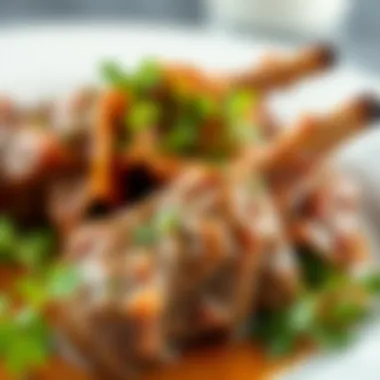A Taste of Tradition: Exploring Emirati Cuisine


Intro
Emirati cuisine is not merely a collection of meals; it is a vivid tapestry woven from the cultural and historical threads of the United Arab Emirates. This culinary tradition reflects influences from the Middle East, South Asia, and North Africa, creating a unique flavor profile that stands apart in the rich tapestry of international dining. Yet, what is it about these traditional dishes that transports diners not just to a table, but into the heart of Emirati heritage?
At family gatherings and community events, Emirati cuisine plays an essential role. Meals are not taken lightly; they are often festooned with communal spirit and laughter among family and friends. In this exploration, we will delve into a series of significant dishes, uncovering their historical roots, intricate preparation methods, and the fresh produce, spices, and herbs that make them special.
As we embark on this culinary journey, we aim to showcase how these traditional meals do more than satisfy hunger; they reflect a way of life and convey a sense of belonging among the Emirati people. Understanding this gastronomic culture proves that food is more than just sustenance—it is a vital part of community and identity.
Join us as we navigate through the fascinating world of Emirati cuisine.
Preamble to Emirati Cuisine
Emirati cuisine is a true reflection of the diverse influences that have shaped the United Arab Emirates over centuries. It brings together the culinary traditions of the Arabian Peninsula, Persian influences, Indian spices, and African flavors, creating a rich tapestry of flavors and techniques. This article seeks to unpack the importance of Emirati cuisine, not just as food but as a cultural emblem that carries the heritage and identity of the people.
The essence of this cuisine goes beyond mere sustenance; it represents a way of life, showcasing the seasonal availability of ingredients, the role of hospitality, and the communal aspects of dining. Through exploring its dishes, one gains insight into the values and social norms of the Emirati society. The dishes that are served at the table tell the tale of family gatherings, festive celebrations, and social cohesion.
Historical Context
To understand Emirati cuisine, it is necessary to delve into its history. Historically, the UAE has been a hub for trade, leading to the fusion of various culinary techniques and traditions. The introduction of spices from India and the Persian influence are noteworthy. Ingredients were largely dictated by geography, and as such, seafood from the Arabian Gulf was prominently featured in traditional meals. An essential dish, Al Harees, encapsulates the simplicity and richness of this culinary arena. The original methods of cooking were often communal, highlighting the importance of sharing meals among families and tribes, which remains a central practice today.
Additionally, the nomadic lifestyle of the Bedouins contributed to the development of regional flavors. Their reliance on preservation methods, such as drying or smoking, laid the groundwork for many dishes that are still appreciated in Emirati households. Each bite of traditional food is laden with stories of survival, culture, and a time when hospitality was paramount.
Cultural Influences
Cultural influences in Emirati cuisine are vast and varied, with each contributing its unique twist that enhances the overall culinary landscape. The crossroad status of the UAE is reflected in its food - it is a meeting point of different cultures. For instance, Indian spices like cardamom and saffron have found a home in many traditional Emirati recipes, making dishes such as Machboos not just a meal, but a melting pot of cultural flavors. The Persian influence can be seen in the tenderness of meat preparations and the use of rice, both staples in many local recipes.
Moreover, the African touch, especially from the coastal regions, influences the preparation methods and specific flavor profiles. The mix of these cultures has given rise to a unique culinary presence that is distinctly Emirati. The communal nature of coffee drinking, paired with dates, symbolizes hospitality and generosity entrenched in Emirati culture, inviting guests to experience the flavors and warmth of the region.
This culinary journey through Emirati cuisine not only satisfies hunger but also serves as a medium for social discourse and a bridge between generations, providing a vital connection to the country's cultural heritage.
Staple Ingredients in Emirati Cooking
The foundation of any cuisine lies in its primary ingredients, and Emirati cooking is no exception. These staples not only define the flavors characteristic of the region but also showcase the cultural interactions and historical journeys of the UAE. The interplay of various elements in Emirati dishes speaks volumes about the lifestyle and values of the Emirati people. Understanding these ingredients is crucial for anyone looking to appreciate the richness of this culinary landscape.
Spices and Herbs
Spices and herbs form the beating heart of Emirati cuisine, creating layers of flavor that elevate traditional dishes. The Emiratis have a profound love affair with saffron, known for its golden hue and aromatic qualities, often used in rice dishes like Machboos. Other spices such as cumin, coriander, and cardamom are just as essential, often blended into spice mixes known as baharat which can add complexity to meals.
Herbs, though not as dominant as spices, provide refreshing contrasts. Cilantro and mint frequently garnish dishes, bringing a vibrant touch to heavy meals.
Using local spices not only enhances the taste but speaks to the influence of trade routes and neighboring countries. Indeed, the art of spicing food is a craft that has been passed down, highlighting both regional preferences and family traditions over generations.
Common Proteins
The choice of protein in Emirati dishes reflects the available resources and the social aspects of eating in the region. From lamb and chicken to fish, these proteins hold a key role in meal preparation. Lamb is celebrated for its tenderness, often slow-cooked to achieve a melt-in-the-mouth texture. On the other hand, chicken is frequently marinated in a blend of spices before grilling or roasting, drawing on the vibrant flavors typical to this cuisine.
Fish is equally important given the location of the UAE near the Gulf. Grilled or stewed fish served with rice often makes appearances on communal dining tables. The choices made regarding protein are a testament to sustainability practices as well, since the Emirati community respects and upholds traditional fishing methods.
Cereals and Grains
Grains are the backbone of many Emirati meals, with rice being the most significant. Varieties like Basmati are preferred, but Emiratis have unique ways of incorporating rice into dishes. The cooking method usually involves boiling rice separately, often seasoned with spices, and then it is layered with the main dish.
In addition to rice, wheat plays a notable role, especially in the form of flatbreads served alongside meals. These breads are typically made fresh and enjoyed warm.


Moreover, ingredients like bulgur and barley gradually find their way into the culinary scene, showing a blend of traditional and contemporary preferences. The use of these grains not only tastes good but also symbolizes nourishment and wellness in daily life.
Notably, the habits surrounding staple ingredients in Emirati cuisine reflect the deep-rooted social structures, community interactions, and the importance placed on family gatherings and shared meals.
For further reading on Emirati cuisine and its distinctive flavors, you may refer to Encyclopedia Britannica or delve into the culinary traditions of the Middle East on Wikipedia.
Understanding these components will provide deeper insight into the significance behind Emirati culinary traditions.
Classic Emirati Dishes
Classic Emirati dishes embody the essence of the UAE's culinary landscape. They represent more than just food; they symbolize the history, culture, and communal bonds that form the backbone of Emirati society. In this article, we explore these traditional dishes, focusing on Al Harees, Machboos, and Luqaimat. Each of these dishes offers a taste of Emirati identity, rooted in local ingredients and historical recipes that have been passed down through generations.
Al Harees
Preparation Process
The preparation process of Al Harees showcases a dedication to tradition. Made primarily with wheat and meat, this dish requires meticulous timing and technique. Typically, the wheat is soaked, ground, and then cooked for several hours with the meat, often chicken or lamb. This slow cooking method allows the flavors to meld beautifully, resulting in a creamy texture that is both satisfying and rich.
A key characteristic is the use of a wooden pestle and mortar, which lends the dish an artisanal touch that embodies the Emirati spirit. The communal aspect of its making plays a role in Turkey tradition; gatherings around the stirring pot foster family bonds and create lasting memories. However, this lengthy process may be seen as a drawback, especially in modern households looking for quicker meals.
Serving Customs
In terms of serving customs, Al Harees is often presented in large, communal dishes, reflecting the social fabric of Emirati life. Traditionally, it is served during Ramadan, weddings, and during Eid celebrations. The act of sharing this dish emphasizes the values of generosity and hospitality prevalent in Emirati culture.
A noteworthy aspect includes the practice of eating it with ghee or sugar, allowing for personalization according to individual tastes. While this custom imbues the dish with an inviting warmth, some may find the idea of sharing from a communal platter less appealing in today's society, where personal space is cherished more.
Machboos
Flavor Profile
Machboos stands out for its rich flavor profile, combining spices such as saffron, turmeric, and cardamom with rice and meat, usually chicken, lamb, or seafood. This dish represents the diverse influences of Persian, Indian, and African cuisines, reflecting the UAE's position as a trading hub throughout history.
The smoky undertones from slow cooking in a sealed pot offer a unique taste that differentiates Machboos from other rice dishes. This complexity, alongside its vibrant colors from the spices, makes it a staple at family gatherings and celebrations. However, the requirement for balancing numerous spices can be challenging for less experienced cooks.
Variations Across Regions
Regional variations of Machboos can offer entirely different tastes, depending on local ingredients and cooking methods. For example, seafood Machboos is popular along the coast, while inland areas may favor lamb versions.
This diversity enriches the culinary landscape, allowing for a personal touch in family recipes. Yet, such variations might lead to debate about what constitutes the authentic Machboos, illustrating the interplay between tradition and evolution in Emirati food culture.
Luqaimat
Ingredients and Preparation
Luqaimat serve as a delightful example of Emirati dessert, primarily made from flour, yeast, and sugar, offering a taste of sweetness in every bite. The dough is deep-fried until golden brown and then drizzled with date syrup or honey, creating a perfect blend of textures and flavors.
The preparation can be simple yet requires attention to detail, particularly in kneading the dough to ensure light, fluffy results. A key feature lies in its versatility; Luqaimat can be enjoyed at festivals or as a treat after meals, making it a widely popular choice among locals and visitors alike. However, frequent frying may pose health concerns.
Popular Culinary Techniques
Popular culinary techniques for making Luqaimat often involve using a metal scoop to achieve consistent shapes, ensuring uniform cooking. Some even employ various toppings, mixing it up with nuts, coconut, or various flavored syrups.
This adaptable approach opens the door to creativity, allowing cooks to experiment and innovate while staying true to traditional roots. However, such experimentation may sometimes stray from the authentic taste that makes Luqaimat essential in Emirati traditions.


By exploring these beloved dishes, we see how they illustrate the depth of Emirati culinary practices, encapsulating shared experiences and the enduring significance of food in community bonding.
Emirati Desserts
Emirati desserts hold a special place in the culinary landscape of the UAE, reflecting the vibrant blend of cultures that characterize the region. These sweet treats are not just desserts; they symbolize tradition, celebration, and community. The importance of these dishes goes beyond their delectable flavors, serving as cultural tie that binds families and communities together, especially during religious and social gatherings.
Knafeh
Despite its Middle Eastern origins, knafeh has garnered a unique position in Emirati cuisine, showcasing a delightful amalgamation of taste and texture. This beloved dessert is made from thin noodle-like pastry, soaked in syrup, and layered with rich cheese. Each region adds its twist, resulting in a rich tapestry of flavors that speaks to the diversity in Emirati culture.
Regional Adaptations
In the UAE, knafeh varies from one region to another, with individual families often having their secret recipes passed down through generations. These adaptations might include local ingredients like date syrup or different kinds of cheese available. These variations highlight the creativity of Emirates in putting their spin on culinary tradition. The unique feature of regional adaptations is how they preserve local identities within a largely shared culinary framework. This not only fosters pride among food lovers but also attracts those eager to experience these distinct flavors. The adaptability of knafeh also allows it to fit into various meals and occasions, providing versatility that is a boon in a world leaning towards homogeneity.
Serving Methods
Knafeh is typically served warm, accompanied by a drizzle of syrup and sometimes topped with pistachios for an added crunch. This method aligns with the cultural practice in the Emirates to enjoy meals hot and fresh; it accentuates the cheese's melt-in-your-mouth texture while offering a delightful contrast with the syrup's sweetness. Many families also serve it during gatherings, sharing alongside Arabic coffee, which adds an extra layer of tradition. However, the downside is that not all knafeh remains as delectable when reheated, a point of concern for hosts who may wish to prepare it in advance. Nonetheless, the warmth and community around serving this dish create a memory that guests cherish long after the last bite.
Dates and Coffee
Emirati culture places immense significance on dates and coffee; they are the quintessential ingredients of hospitality and tradition. The ritualistic offering of dates and Arabic coffee symbolizes generosity and friendship, creating a warm welcome for guests.
Significance in Emirati Culture
In the UAE, dates are more than just a fruit; they are rich in nutrients and form a key part of the Emirati diet. Often served during Ramadan for iftar, they embody the spirit of sharing and community. The unique connection of dates to the local environment helps solidify their status as an essential part of Emirati identity. Furthermore, offering dates alongside coffee is a sign of respect to guests, showcasing the values of generosity and hospitality that are central to Emirati culture. The benefits of emphasizing dates and coffee in this article are clear—they highlight not just the food itself but the ethos of a culture intertwined with these elements.
Preparation of Arabic Coffee
Arabic coffee, often brewed from lightly roasted Arabica beans and flavored with cardamom, is a craft in itself. Preparation is meticulous: the coffee is brewed slowly, allowing flavors to meld beautifully, culminating in a beverage celebrated for its aroma and warmth. This method fosters social interaction, as serving coffee is often a leisurely and ritualistic process. The unique aspect of Arabic coffee is its decaffeinated nature, allowing guests to relish the flavors without the caffeine jitters. Although preparation can be time-consuming, the resulting drink is seen as a mark of sophistication and a celebratory beverage worth the effort. Incorporating Arabic coffee into discussions provides deeper insights into how traditions manifest in simple yet significant ways in Emirati life.
The fusion of sweets, from knafeh to dates and coffee, exemplifies the deep-rooted traditions in Emirati culture while adapting gracefully to the modern culinary landscape.
Emirati desserts thus illuminate not just the palate but also the heart of the community, crafting a narrative rich in history, creativity, and cultural identity.
Culinary Practices and Traditions
Emirati culinary practices and traditions are deeply woven into the fabric of social life within the UAE. These practices do not merely revolve around food preparation but are manifestations of community connections, cultural heritage, and the endurance of passed-down skills through generations. One can hardly fathom Emirati cuisine without acknowledging these culinary customs that shape how meals are experienced and enjoyed.
Social Aspects of Dining
Dining in Emirati culture is seen as a communal activity, where sharing food signifies hospitality and generosity. This rich tapestry is woven from years of history and tradition, drawing on influences from neighboring cultures while maintaining a unique identity.
Gathering around a shared meal breaks down barriers, fostering camaraderie and strengthening ties among family, friends, and even strangers. When one dines together, the act transcends mere nourishment; it becomes a ritual of connection.
"Food is not just fuel; it’s a bridge between hearts."
Different aspects of social dining exist, including the use of communal dishes that everyone shares, facilitating a sense of togetherness. Traditionally, meals may be served on large platters, where diners gather around to partake in a feast, engaging in lively conversation—this contrasts sharply with the more individualistic dining styles.
Family Gatherings and Feasts
Family gatherings in Emirati culture are significant, often marked by elaborate feasts that celebrate important occasions and cultural festivities. The act of gathering speaks volumes about the importance of family, where the kitchen often serves as the heart of the home.
Role of Food in Social Bonds


The role of food in social bonds is prominent. Shared meals provide a platform where stories are exchanged, showcasing a tapestry of rich experiences and histories. It is a chance to learn from one another, creating a legacy through flavors and shared memories. In the context of family gatherings, these meals often include traditional dishes, making them a hallmark of celebrations.
The characteristic that stands out here is how food serves as a means of expressing love and care. People prepare meals with thoughtfulness, using recipes that have been handed down, even adding their flair over time. This unique feature fosters not only a sense of belonging but also a deep appreciation for one’s heritage, celebrating the elder generation's role in storytelling through food.
Seasonal Festivities
Seasonal festivities in the UAE are often grand, bringing communities together, and food plays a central role here. Holidays such as Eid al-Fitr and National Day feature specific dishes that mark the occasion. During these times, culinary displays become both an art form and a means of honoring cultural traditions.
The uniqueness of these festivities lies in their ability to connect people across different walks of life. When a community prepares traditional dishes for such occasions, it reinforces cultural identity and unity amidst diversity.
Thus, through seasonal festivities, family and community bonds are strengthened, creating a rich tapestry of cultural history that is celebrated over plates filled with hearty traditional dishes. Each meal tells a story, links generations, and holds a cherished place in the social fabric of the Emirates.
In essence, the culinary practices and traditions in Emirati cuisine are not merely about what is eaten. It's about how food connects people across generations, reinforcing bonds and showcasing cultural pride through shared experiences.
Modern Influences on Emirati Cuisine
In today’s dynamic world, the face of Emirati cuisine has morphed substantially, presenting a curious blend of tradition and modernity. As the UAE embraces global trends while preserving its traditional roots, these modern influences are not just an ornament; they’re woven into the very fabric of contemporary Emirati culinary experiences.
Fusion Dishes
Fusion dishes have emerged as an exciting aspect of Emirati cuisine. This culinary approach blends traditional Emirati flavors with international techniques, creating unique offerings that reflect a modern palete. For instance, consider a dish like machboos tacos, where the spices and methods from the beloved traditional rice dish come together with the casual street food appeal of tacos. Such creative endeavors not only appeal to a wider audience but also celebrate the melding of different culinary identities.
The introduction of ingredients from across the globe – such as avocados, smoked salmon, and even truffle oil – shows how chefs are pushing boundaries. This mix doesn’t merely happen; it comes through experimentation and open-mindedness in the kitchen. People with diverse backgrounds cook side by side, which leads to radical and flavorful inventions.
Benefits of Fusion Dishes:
- Culinary Creativity: Chefs showcase their innovation while recognizing historical roots.
- Global Appeal: Attracts tourists and expatriates, making local eateries competitive on a global scale.
- Cultural Exchange: Promotes an environment where culinary arts from various backgrounds can coexist.
Emergence of Emirati Restaurants
As more Emirati restaurants pop up, there’s a growing appreciation for the nuances that define Emirati cuisine. No longer confined to homes or special occasions, dining out has transformed into an exploration of heritage. Locations like Bu Qtair in Dubai or Al Fanar offer not just a meal, but an experience steeped in local culture. These eateries focus on delivering authentic dishes while often incorporating contemporary dining styles that resonate with the modern diner.
Restaurants are also embracing sustainability; many source ingredients locally and even promote organic farming. This is important for not just supporting community agricultural practices but also respecting the environment. This shift reflects a conscientious effort to honor traditions while moving forward.
A notable trend among these establishments is the focus on presentation and ambiance, which often includes traditional music or art reflecting the Emirati culture. This elevates the dining experience from a mere meal to a narrative.
Key Highlights of Emirati Restaurants' Emergence:
- Authenticity: A deep respect for traditional recipes while innovating within the framework.
- Community Involvement: Engagement with local suppliers and farmers leading to fresh, quality ingredients.
- Cultural Showcase: Each restaurant serves as a cultural ambassador, making Emirati cuisine accessible to both residents and tourists.
"Dining in an Emirati restaurant transcends mere sustenance; it offers a taste of the nation’s heart and soul."
Epilogue
Emirati cuisine is not just about the food; it embodies a rich tapestry of history, culture, and community values that define the United Arab Emirates. As the world moves forward at a blistering pace, it becomes reflexively important to recognize how traditional dietary practices sustain connection amongst people. In this regard, the skillfully prepared dishes offer moments of reflection, celebration, and togetherness, serving both nourishing bodies and feeding bonds.
Sustaining Tradition in the Modern Era
The challenge of sustaining traditions in our contemporary world looms large. With the culinary landscape evolving due to globalization and fusion trends, the essence of traditional dishes might feel threatened. However, Emirati cuisine demonstrates remarkable resilience. Chefs at restaurants like Al Fanar and 3 Fils are not merely serving food; they are curating experiences that carry the weight of generations. By keeping recipes alive while also incorporating modern twists, they walk the fine line between innovation and preservation.
Tradition, in many ways, serves as the backbone of communal identity. The significance of sharing a meal that showcases age-old recipes fosters understanding and retroacts as educational moments for younger generations. Parents and grandparents play a crucial role in passing down customs, such as preparing Machboos during festive seasons, ensuring that familial ties remain intact.
Keeping the culinary practices alive also has socio-economic implications. As tourists flock to the UAE, authentic Emirati cuisines become attractions that not only enhance cultural appreciation, but also establish a source of income for local businesses. This further strengthens the advocacy for preserving Emirati food heritage in a rapidly expanding global marketplace.
In essence, sustaining tradition is about keeping alive the stories embedded in each dish. Dates and coffee, for instance, are not just about consumption; they symbolize hospitality and heritage. The blend of flavors in recipes like Luqaimat speaks volumes about the cultural intersections—showing how shared experiences through food cultivate a sense of belonging.
Ultimately, as Emirati cuisine continues to evolve, the challenge is not to lose sight of where it all began. It is about ensuring future generations can dive into the depths of their culinary heritage, savoring not just the taste but also the profound connections these dishes represent. By embracing both modernity and tradition, Emirati cuisine can shine brightly on the global stage, illuminating the path forward for both food enthusiasts and cultural custodians alike.
"Culinary journeys shape our identities, connecting us to our past while guiding us toward the future."
For more insights into Emirati cuisine and its cultural significance, consider visiting Britannica, Wikipedia, or engaging in discussions at Reddit.















